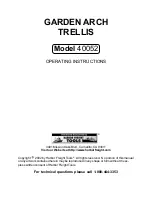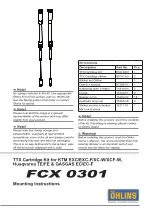
Theory of Operation— 2440 Service
Sample-and-Hold outputs of both CH 1 an CH2 are gated
in turn to the A/D Converter. The cycle then repeats until
1024 samples from all four sides of both CCDs have
been converted.
NOTE
The samples are docked through each side of the
CCD at a 500 kHz rate, resulting in an output
sampling rate of 2 MHz per channel. Also note that
the 8-to-1 gating of the two channels and their
respective outputs results in a 4 MHz time-
multiplexed (8-to-1) signal to the A/D Converter.
For Short-Pipeline sampling mode, the gating for the
inputs to the Sample-and-Hold circuits is the same as in
FISO mode. However, since only one side of each CCD is
used per channel, only one pair of differential outputs (per
CCD) and the corresponding Gain-Cell amplifier and
Sample-and-Hold
circuits
transfers
valid
waveform
samples to the A/D Converter. The Short-Pipeline mode
save-acquisition clocking ensures that only the valid
converted data is saved (see “Short-Pipeline Mode" in
“Acquisition Process and Control”). Observe, however,
that the signal to the A/D Converter is still a 4 M Hz time-
multiplexed signal, but with invalid data half of the time.
Since the invalid data is, in effect, discarded by the Short-
Pipeline Mode save-acquisition clocking, the A/D Converter
continues to operate at a constant 4 M Hz conversion rate
as in FISO mode.
The time-multiplexed signal is applied to the input of the
A/D Converter circuit for digitization. The System Clocks
circuit (diagram 7) provides a 4 M H z clock to the
converter, for a 4 M H z data-conversion rate of the input
signal. The resulting digital output byte is applied in four
8
-bit bytes to the Acquisition Latches (diagram 15).
For Normal and Average Acquisition Modes, data is
clocked into the Acquisition Latches by another 4 M Hz
clock time-shifted from the 4 M Hz clock used by the A/D
Converter. Enabling of the outputs of the Acquisition
Latches is controlled by the CCD D ata clocks in a
sequence that ensures that the data clocked out from the
enabled latch corresponds to the CCD side and Sample-
and-Hold circuit that provided it. The
8
-bit sample bytes
are then saved in Acquisition memory in the same order
they were obtained. This “structured” method for saving
acquisitions keeps the data in the correct tim e sequence
for display.
For Envelope Mode, the Time Base Controller disables
continuous gating of the 4 M Hz clock to the Acquisition
Latches. This action turns over the gating of that clock to
the Envelope M in-M ax Com parators (diagram 15). With
the 4 M Hz clock ungated, the CCD D ata Clocks will
continue to control the enabling of the outputs of the
acquisition latches as described, but the new data bytes
are not continually clocked into the latches. The result is
that only the data bytes clocked in by the Envelope Min-
Max
Com parators
are
sequentially
clocked
to the
Envelope Data bus in the following manner: CH 1 max,
CH 2 max, CH 1 min, CH 2 min. This is the same order in
which the analog samples are clocked into the A/D
Converter.
The output of the A/D Converter is fed to the Envelope
M in-M ax Com parators (diagram 15). The outputs of the
Acquisition Latches are also fed back to those compara
tors. Due to the previously described timing action of the
CCD Data Clocks, the newly digitized minimum or max
imum value from the Peak Detectors (see “Input Signal
Conditioning and Analog Sampling”) is compared to the
last value
latched
into the Acquisition
Latch that
corresponds to the new point. If the newly acquired point
is outside the previous min or max value, the appropriate
Envelope M in-M ax Com parator gates the 4 M Hz clock,
and the new data byte is latched into the corresponding
acquisition latch.
ACQUISITION PROCESSING
AND DISPLAY
Data Transfer to SAVE Memory
Once the 1024 digitized signal bytes per channel are in
Acquisition Mem ory, the Tim e Base Controller ungates the
SAVEACQ clock and switches the the Mem ory Mode Con
trol circuit to the W aveform
nP.
It also signals the
W aveform
via the Display Status Buffer (diagram 2),
that the acquisition is complete. The W aveform
tiP
can
then access the Acquisition Memory.
When the W aveform
nP
reads the acquisition done
(ACQDN) signal from the Time Base Controller, it writes
an address (via the Address Latch) which is decoded by
the Register Address Decoding circuit (diagram 2). The
decoded
address
signals
the
Record-End
Latch
(diagram
8
) to enable its contents (the last addressed
memory location for the stored acquisition) to the
W aveform
nP
data bus to be read to determ ine the loca
tion of the last record byte stored. The W aveform
nP
then
uses that location to determine the location of any byte in
Acquisition Memory.
The W aveform
nP
outputs (via its Address Latch)
addresses to the Address Counter for Acquisition Memory.
The Address Counter is held in its load mode by the
W aveform *tP (via the Memory Mode Control circuit), pass
ing the address through to Acquisition Memory. The
W aveform
nP
enables the Acquisition Memory and
provides the clocks (via the Mem ory Mode Control circuit)
3-12
Summary of Contents for 2440
Page 4: ......
Page 12: ......
Page 38: ......
Page 91: ...Theory of Operation 2440 Service 3 49 Figure 3 5 Simplified CCD architecture ...
Page 120: ...Theory of Operation 2440 Service Figure 3 10 DC Restorer 3 78 ...
Page 130: ...Theory of Operation 2440 Service 3 88 ...
Page 136: ...Theory of Operation 2440 Service Figure 3 15 PWM Regulator and Inverter 3 94 ...
Page 138: ...Theory of Operation 2440 Service Figure 3 16 PWM switching waveforms 3 96 ...
Page 208: ......
Page 322: ......
Page 419: ......
Page 423: ...2440 Service Figure 9 4b 2440 Block diagram part 2 6330 27 BLOCK DIAGRAM PART 2 ...
Page 427: ......
Page 428: ...2440 Service WAVEFORMS FOR DIAGRAM 1 6 2 8 5 3 2 ...
Page 429: ......
Page 432: ...2440 Service WAVEFORMS FOR DIAGRAM 2 BUS ISOLATED 6 6 0 3 4 9 ...
Page 433: ...WAVEFORMS FOR DIAGRAM 2 ...
Page 439: ......
Page 445: ......
Page 450: ...2440 Service WAVEFORMS FOR DIAGRAM 8 6603 27 ...
Page 455: ...W A V EFO R M S FOR D IAG RAM 11 WAVEFORMS FOR DIAGRAM 11 6603 29 ...
Page 458: ...WAVEFORMS FOR DIAGRAM 12 ...
Page 463: ...WAVEFORMS FOR DIAGRAM 14 ...
Page 471: ... C N i u i t e x r 4 j u J l i 1 i 6 28 5 44 WAVEFORMS FOR DIAGRAM 18 ...
Page 476: ...WAVEFORMS FOR DIAGRAM 20 ...
Page 490: ...YES ...
Page 492: ......
Page 494: ......
Page 499: ...YES ...
Page 501: ......
Page 502: ...2440 Service FIG 1 C A B IN E T ...
Page 503: ......
Page 510: ...2440 Service SISSVHO Z Old ...
Page 511: ......
Page 512: ...A12 2440 Service F IG 3 C IR C U IT BOARDS ...
Page 513: ......
Page 517: ...10 16 R E V J U L 1993 Replaceable Mechanical Parts ...
Page 518: ...2440 Service ...
Page 519: ...FIG 4 L V H V PWR SUPPLY ...
Page 520: ...FIG 5 ACCESSORIES 2440 Service ...
Page 521: ......
Page 523: ......
Page 529: ......
Page 530: ......
Page 531: ......
















































